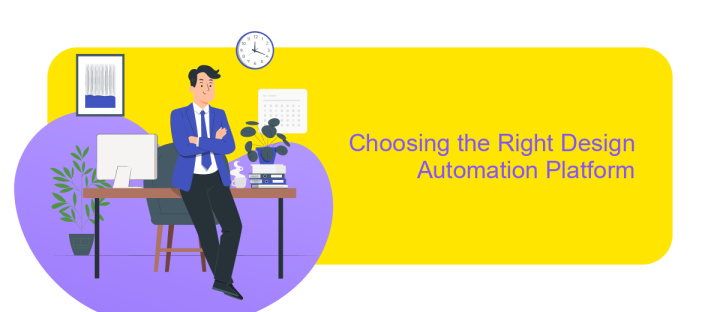Design Automation Platform
In today's fast-paced digital landscape, a Design Automation Platform is revolutionizing how businesses approach design processes. By streamlining workflows and enhancing efficiency, these platforms empower teams to produce high-quality designs with greater speed and accuracy. As industries increasingly prioritize innovation and adaptability, embracing design automation becomes essential for staying competitive and meeting the ever-evolving demands of the market.
Introduction to Design Automation Platforms
Design automation platforms are revolutionizing the way industries approach complex design processes. These platforms integrate advanced computational tools and algorithms to streamline the creation, modification, and optimization of designs across various domains. By automating repetitive tasks and providing intelligent design suggestions, they significantly reduce time-to-market and enhance product quality.
- Efficiency: Automates routine tasks, allowing designers to focus on creativity and innovation.
- Consistency: Ensures uniformity across designs, minimizing errors and rework.
- Scalability: Adapts to projects of varying sizes and complexities.
- Collaboration: Facilitates seamless teamwork through shared digital environments.
As technology continues to advance, design automation platforms are becoming indispensable tools for businesses aiming to maintain a competitive edge. Their ability to integrate with existing systems and adapt to evolving industry standards makes them a critical component in modern design strategies. By embracing these platforms, organizations can not only boost their productivity but also foster innovation and creativity, ultimately leading to superior products and services.
Key Features and Capabilities

The Design Automation Platform offers a comprehensive suite of features that streamline the creative process, enhancing productivity and collaboration. With its intuitive user interface, designers can effortlessly create, modify, and manage design projects, ensuring a seamless workflow from inception to completion. The platform supports a wide array of design formats, allowing for versatile project handling and reducing the need for multiple tools. Advanced collaboration tools enable teams to work in real-time, sharing feedback and updates instantly, which fosters a more cohesive and efficient creative environment.
Integration capabilities are a standout feature of the platform, allowing seamless connectivity with other essential tools and services. With ApiX-Drive, users can automate data transfers and synchronize information across various applications without the need for extensive coding knowledge. This not only saves time but also minimizes errors, ensuring that all design elements are consistently updated. Additionally, robust security measures protect sensitive design data, providing peace of mind for users. Overall, the platform's key features are designed to empower designers, offering them the flexibility and control needed to innovate and excel in their projects.
Benefits of Using a Design Automation Platform

Implementing a Design Automation Platform can significantly enhance the efficiency and effectiveness of design processes across various industries. By automating repetitive tasks and streamlining workflows, these platforms allow design teams to focus on creativity and innovation rather than getting bogged down by mundane tasks.
- Increased Productivity: Automation reduces manual intervention, speeding up the design process and allowing teams to deliver projects faster.
- Cost Efficiency: By minimizing errors and reducing the need for rework, automation platforms help in cutting down operational costs.
- Consistency and Accuracy: Automated processes ensure that design outputs maintain a high level of consistency and precision, which is crucial for maintaining quality standards.
- Scalability: A design automation platform can easily adapt to increased workloads, making it easier to scale operations as business needs grow.
- Improved Collaboration: These platforms often come with features that enhance team collaboration, ensuring that all stakeholders are aligned and informed throughout the design process.
Overall, adopting a Design Automation Platform empowers organizations to not only improve their design capabilities but also to gain a competitive edge in their respective markets. As technology continues to evolve, the importance of such platforms in driving innovation and efficiency cannot be overstated.
Choosing the Right Design Automation Platform

When selecting a design automation platform, it's crucial to consider the specific needs of your project. The right platform should not only streamline your workflow but also enhance collaboration among your team members. Evaluate the complexity of your designs and the level of customization required to ensure the platform can meet your demands.
Another factor to consider is the integration capabilities of the platform. A seamless integration with existing tools and software can significantly improve efficiency. Look for platforms that offer robust API support and compatibility with popular design tools to facilitate a smooth transition and minimize disruption.
- Assess the platform's scalability to accommodate future growth.
- Consider the level of customer support and resources available.
- Evaluate the cost-effectiveness and return on investment.
- Check for user reviews and testimonials for real-world insights.
Ultimately, the right design automation platform should align with your strategic goals and provide a flexible, user-friendly experience. By thoroughly assessing your options and prioritizing key features, you can ensure that the platform you choose will support your design processes effectively and sustainably.
- Automate the work of an online store or landing
- Empower through integration
- Don't spend money on programmers and integrators
- Save time by automating routine tasks
Future Trends in Design Automation
As the landscape of design automation evolves, one of the key future trends is the integration of artificial intelligence and machine learning into design processes. These technologies are set to enhance the efficiency and accuracy of design automation tools, enabling them to predict and rectify errors before they occur. By leveraging AI, design platforms can offer more personalized and adaptive solutions, catering to the specific needs of diverse industries. This trend is likely to reduce manual intervention, thereby speeding up the design cycle and allowing designers to focus more on creativity and innovation.
Another significant trend is the increasing demand for seamless integration between various design tools and platforms. Services like ApiX-Drive are at the forefront of this movement, providing automated integration solutions that connect disparate systems without the need for complex coding. Such integrations are crucial for maintaining a cohesive design ecosystem, ensuring that data flows smoothly between applications. As design automation continues to grow, the ability to effortlessly connect and synchronize tools will become essential, driving further advancements in collaborative and cloud-based design environments.
FAQ
What is a Design Automation Platform?
How does a Design Automation Platform improve efficiency?
Can a Design Automation Platform integrate with other software tools?
How can I implement automation in my design processes?
What are the benefits of using a Design Automation Platform?
Strive to take your business to the next level, achieve your goals faster and more efficiently? Apix-Drive is your reliable assistant for these tasks. An online service and application connector will help you automate key business processes and get rid of the routine. You and your employees will free up time for important core tasks. Try Apix-Drive features for free to see the effectiveness of the online connector for yourself.


